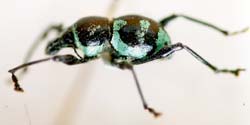Opals manufactured by beetles

The weevil Pachyrhynchus argus, found in forests in north-eastern Queensland, Australia. This animal produces a photonic crystal structure analogous to that of opal <br>Credit: University of Oxford
The gemstone opal could be manufactured synthetically copying a technique employed by a beetle to control the appearance of its outer shell.
Researchers from the Department of Zoology at the University of Oxford have discovered the first case of opal in an animal, in this case in the weevil Pachyrhynchus argus, found in forests in north-eastern Queensland, Australia. This animal produces a photonic crystal structure analogous to that of opal, which gives it a relatively uniform, metallic colour.
This colour derives from very thin, flat scales which occur in patches on the top and sides of the beetle’s body. The scales consist of an outer shell and inner structure. The inner structure is a solid array of transparent nano-spheres, arranged in flat layers in a precise hexagonal packing order. This arrangement allows light to be broken and reflected in the same way as found in opal and can therefore be seen as an opal-like structure.
Unlike gemstone opal, however, the weevil opal results from chemical ‘factories’ within cells, a technique which could be copied by manufacturers of synthetic opal. Dr Andrew Parker and Dr Victoria Welch at Oxford have begun unravelling this complex assembly line.
Dr Parker said: ‘The optical effect created by this weevil makes it appear strongly coloured whatever angle you look at it. This is important for its behaviour and recognition because it can appear brightly coloured in the same pattern from any direction. If we can decipher and emulate the weevil’s means of opal production it would represent a technological breakthrough, particularly since opal has numerous industrial applications, for example in optical circuit boards.’
Media Contact
More Information:
http://www.ox.ac.ukAll latest news from the category: Life Sciences and Chemistry
Articles and reports from the Life Sciences and chemistry area deal with applied and basic research into modern biology, chemistry and human medicine.
Valuable information can be found on a range of life sciences fields including bacteriology, biochemistry, bionics, bioinformatics, biophysics, biotechnology, genetics, geobotany, human biology, marine biology, microbiology, molecular biology, cellular biology, zoology, bioinorganic chemistry, microchemistry and environmental chemistry.
Newest articles

Magnetic Memory Unlocked with Energy-Efficient MRAM
Researchers from Osaka University introduced an innovative technology to lower power consumption for modern memory devices. Stepping up the Memory Game: Overcoming the Limitations of Traditional RAM Osaka, Japan –…

Next-Level System Security: Smarter Access Control for Organizations
Cutting-Edge Framework for Enhancing System Security Researchers at the University of Electro-Communications have developed a groundbreaking framework for improving system security by analyzing business process logs. This framework focuses on…

How Microbial Life Shapes Lime Formation in the Deep Ocean
Microorganisms are everywhere and have been influencing the Earth’s environment for over 3.5 billion years. Researchers from Germany, Austria and Taiwan have now deciphered the role they play in the…



